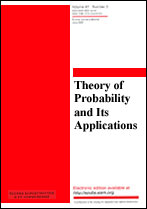|
Quantifying minimal noncollinearity among random points
I. Pinelis
Department of Mathematical Sciences, Michigan Technological University, Houghton, Michigan, USA
Abstract:
Let $\varphi_ {n, K} $ denote the largest angle in all the triangles with vertices among the $ n $ points selected at random in a compact convex subset $ K $ of $\mathbb {R}^ d $ with nonempty interior, where $ d\ge2 $. It is shown that the distribution of the random variable $\lambda_d (K)\,\frac {n^ 3}{3!}\,(\pi-\varphi_ {n, K})^{d-1} $, where $\lambda_d (K) $ is a certain positive real number which depends only on the dimension $d$ and the shape of $K$, converges to the standard exponential distribution as $n\to\infty$. By using the Steiner symmetrization, it is also shown that $\lambda_d (K)$, which is referred to in the paper as the elongation of $K$, attains its minimum if and only if $K$ is a ball $B^{(d)}$ in $\mathbf {R}^d$. Finally, the asymptotics of $\lambda_d(B^{(d)})$ for large $d$ is determined.
Keywords:
convex sets, random points, geometric probability theory, integral geometry, maximal angle, convergence in distribution, Steiner symmetrization, asymptotic approximation.
Received: 28.05.2017
Citation:
I. Pinelis, “Quantifying minimal noncollinearity among random points”, Teor. Veroyatnost. i Primenen., 62:4 (2017), 753–768; Theory Probab. Appl., 62:4 (2018), 604–616
Linking options:
https://www.mathnet.ru/eng/tvp5145https://doi.org/10.4213/tvp5145 https://www.mathnet.ru/eng/tvp/v62/i4/p753
|


| Statistics & downloads: |
| Abstract page: | 318 | | Full-text PDF : | 56 | | References: | 50 | | First page: | 12 |
|




 Contact us:
Contact us: Terms of Use
Terms of Use
 Registration to the website
Registration to the website Logotypes
Logotypes








 Citation in format
Citation in format 